RECOIL OFFGRID Survival The Human Factor: John Hearne Discusses Building Better Survivors
In This Article
The last decade has seen a veritable explosion of firearms and tactical instructors. While these skills are no doubt vital to possessing a well-rounded survival repertoire, the underlying historical and psycho-emotional factors of interpersonal violence are rarely discussed — let alone trained — by most of our favorite instructors. These issues are far less entertaining to talk about, and require far more effort to reach instructional proficiency. Enter John Hearne and his company Two Pillars Training. Part professor and part gunslinger, Hearne has carved out a unique and under-served niche in today’s go-fast social-media-forward training market. He possesses both an extensive career as a federal law enforcement officer and advanced academic degrees requiring finely tuned research capabilities. This unicorn combination of personality and experience has endowed him with a unique knack for studying the more erudite components of surviving violent encounters, focused primarily on human evolution and historical case study. After attending a pair of his lecture classes revolving around these aspects of survival, we took the opportunity to sit down with him, one-on-one, and hear a little more about who he is and how he landed in the unique position of training armed and prepared citizens alike on the intellectual nature of up-close-and-ugly violent crises.
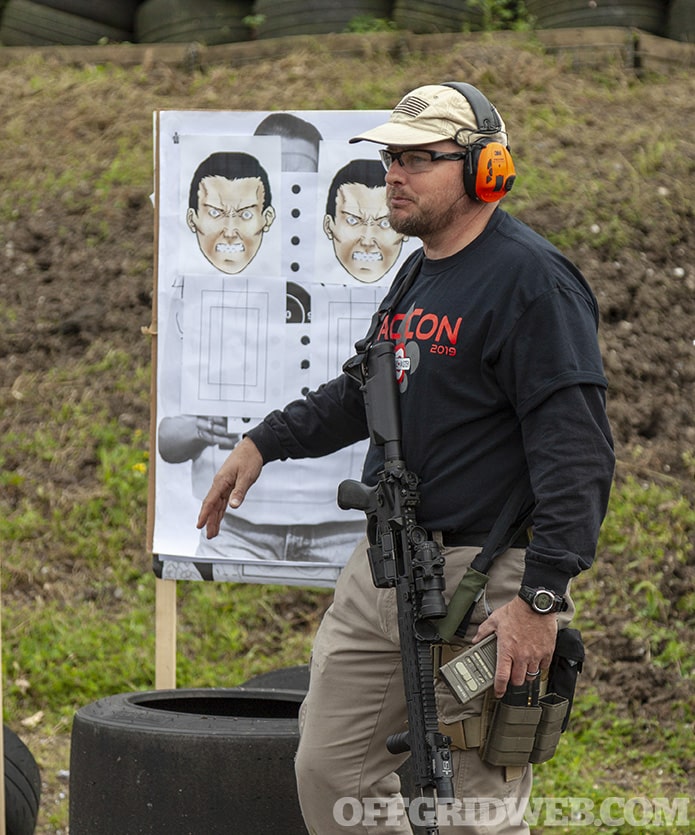
Above: As an active Federal LEO, Hearne has extensive training in both pistol and carbine employment.
RECOIL OFFGRID: Tell us a little about where you’re from originally.
JOHN HEARNE: I was born and raised in a small town in rural Virginia. When I write small, I mean a population of 300 or so. I was raised in an intact two-parent household with my grandparents living next door. It was a classic rural upbringing; we lived on the edge of town, and I could wander the local fields and forests after school. I could hunt small game in the woods behind our house or go quail hunting with my dad. My grandparents were great as well; I could go and shoot anything unfortunate enough to turn up in front of me and my grandfather would clean it for me. Then, my grandmother would cook it. The only thing “unique” was my parents managed to send me to a private college prep school from the fifth grade on, so I had a huge head start in the education department.
The whole time I was growing up, my dad was active in the local volunteer fire department and would end up serving as chief. I grew up playing in the firehouse, and I joined the fire department when I was 16 and became an EMT when I was 17. I’d say an attitude of public service was instilled in me fairly early.
How did you get into a career in law enforcement?
JH: My dad had been a reserve deputy in Florida prior to my arrival in the world and he would end up as a special police officer when I was a teenager. My great-grandfather had been the sheriff of Wicomico County, Maryland, and I remember hearing stories about him from my dad. Also, several of the volunteer firefighters I served with were deputy sheriffs or local police officers, so law enforcement seemed like a normal job to me.
When I was 17, I got a (deserved) speeding ticket. I thought that if I knew how RADAR and such worked, I might be able to avoid a repeat of that experience. I started to do ride-alongs with a local police officer and later some deputy sheriffs. I quickly became fascinated by the job and thought it might make a good career. I was able to start as a part-time dispatcher, which gave me my first glimpse behind the curtain.
At the time I was still in college, I found out that the National Park Service hired part-time officers and my dad encouraged me to apply. I had every intention of working for a few years and then using the experience to get hired by a more prestigious agency. I continued to work summers through graduate school to gain experience and I really enjoyed how the agency provided all the emergency services — fire, EMS, and SAR. I ended up working nine years on a part-time basis and was hired for a full-time position in 2000. At this point, I don’t think I’m transferring to another agency and will probably make a career out of it.
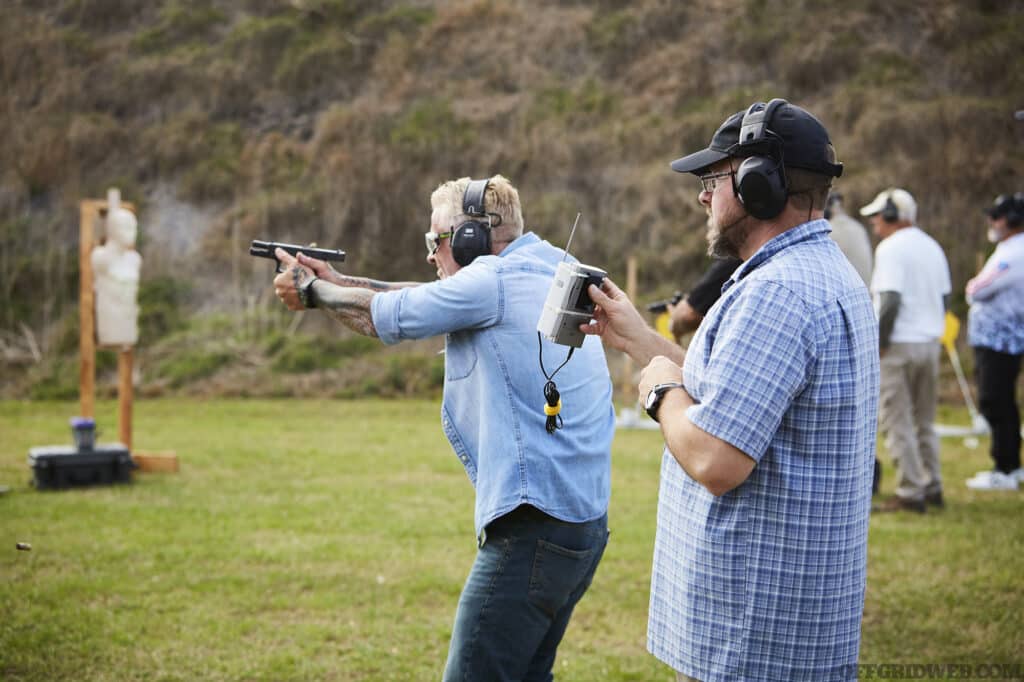
Above: Students working through concealed-carry pistol work.
We know you’re still on active duty, but what has been your most challenging assignment thus far? What about your favorite one?
JH: My most challenging assignment may sound bizarre. Due to a lack of prosecutors, cases in the certain large Western parks use an agency representative to handle all of the misdemeanors and initial proceedings on felonies. You don’t have to be a formally trained lawyer, and to be fair, an effective cop knows the law as well as most attorneys do. You attend a one-day course to familiarize yourself with basic criminal procedure and the local rules. I was given a point of contact in case I had any questions, a point of contact who really didn’t return phone calls.
I found myself in charge of a small prosecutors’ office for the summer in Yosemite National Park. I had two law students and a part-time secretary to assist with a previously poorly managed case load, which had resulted in a massive backlog. We conducted all of the expected business from initial appearances to plea negotiations to conducting trials. We had to deal with all of the crimes that were occurring that summer as well as the backlog. Prior to this experience, I thought I wanted to go to law school. This experience thoroughly disabused me of that notion. This was a great chance to get a different view behind the curtain, an ugly view to the inner machinations of the legal system — note I did not write “justice system.”
I’ve had a lot of assignments I really enjoyed. If I had to pick one, I’d have to choose my time with our field training program. This program takes officers who have just graduated from the academy and helps them apply the abstract knowledge they should have gained in the academy to the real world. From 2004 to 2016, I served as a field training officer, field training supervisor, and member of our national advisory council. I’ve always enjoyed teaching and our team was consistently able to take people with limited experience and get them up to the required performance level. Arguably, more important were the cases where we recommended someone’s removal from the law enforcement profession as they were fundamentally unsuited for the job. It has been very rewarding to see rangers that I helped train, excel in the field, make good cases, and eventually move up to higher positions in the agency or lateral to a “cool guy” agency like the U.S. Marshall Service.
Is your law enforcement career what got you into shooting competitively?
JH: I wouldn’t say it was my law enforcement career per se that got me into competitive shooting but rather poor law enforcement training. I was one of the last people in my agency to give up their revolvers as we made the transition to semi-automatic pistols. I was a pretty good shot with my GP-100, and while I never shot a perfect 300/300, I was always chasing it and tended to shoot in the high 290s. The semi-automatic transition course was supposed to be a three-day, 24-hour class. Instead of three days, I got four or five hours, most of which was in the classroom. We went to the range, shot a few drills, and attempted the qualification. I passed the qualification course in the low 270s. I was told that I was “good enough” since I still shot 90 percent, and the class ended.
I was honestly horrified at the difference between shooting ability between the two platforms and wanted to get back to where I was shooting with the revolver. As far as I could tell, nobody in the agency really knew enough to make that happen. At the same time, Front Sight was starting its move to Las Vegas and hosted an open house that I attended since I was living in the area. I was able to get a significant discount on my first class and drove to Bakersfield, California, for their four-day handgun class. I know that “all the cool kids” like to make fun of Front Sight, but in the late ’90s it was a dramatic improvement over any training I had ever experienced. I did very well in the class, and it opened the door of the private sector training world to me.
It has long been common practice to recommend shooting competitively, and I’m pretty sure it was recommended in one of the Front Sight lectures. It was also at this time that I started paying more attention to gun magazines, as this was pre-internet and they were the only source for information. I started to look for local matches to shoot. I tried IDPA and wasn’t overly impressed. The club where I was shooting also hosted matches under the Paladin System that Rick Miller established. These were very seriously defensive-minded shooters who ran hot ranges and mixed long-gun stages with man-on-man events into every monthly match. I started traveling in the local area and would shoot whatever match worked with my schedule but never missed the monthly Paladin Match.
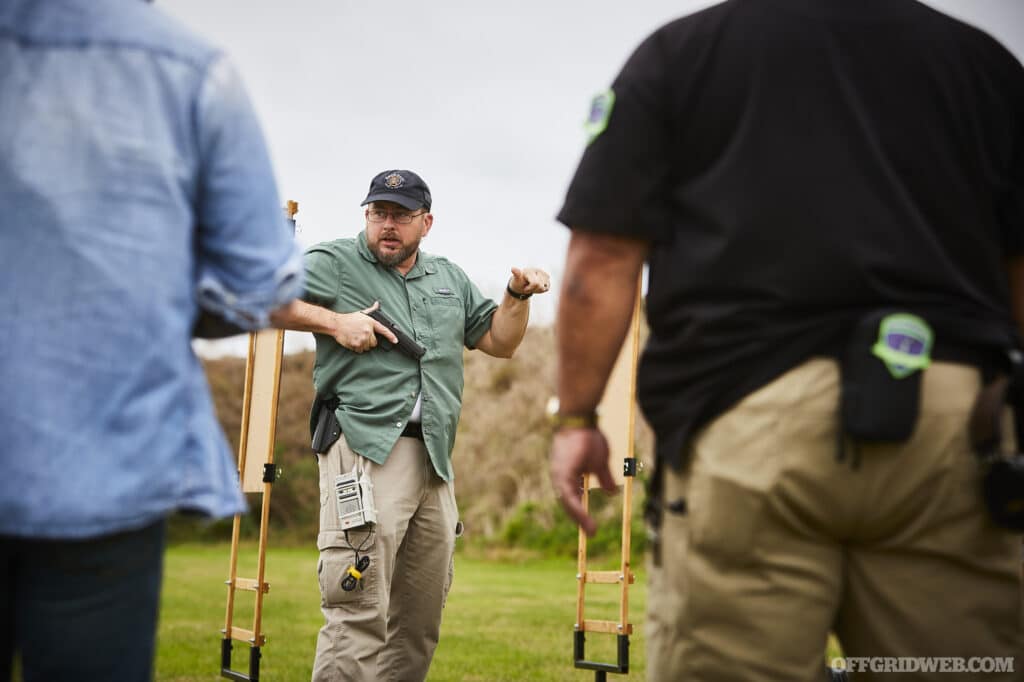
Above: John Hearne discusses concealed carry tactics.
There is still some debate over the efficacy of how competition shooting translates into duty/defensive firearms use. What has been your experience in this regard?
JH: This is a great example of a question where the two offered answers tend to be at extremes, and neither is right. There are those who say that competition has lots of translation, and those that claim it has none. The truth lies somewhere in the middle — it has some clear value, and how the individual engages with it really determines the ultimate value.
The people that proclaim the high value of competition often overlook the heavily scripted nature of most matches. Most matches tend to allow for the rote memorization of the course of fire. This negates a lot of the potential value of having to solve problems on the fly with imperfect information. Doing well tends to be rooted in how well you build and run your shooting plan and deal with any exigencies that occur in the middle of that plan.
The people who say competition has no value are as equally disconnected from reality. A lot of folks who discount competitive shooting simply don’t like the objective measure of their skill that competition can provide. People with very low levels of skill will avoid competition as an ego defense because they don’t want to finish in the bottom 10 percent. These people are also discounting the direct experience of famous gunfighters who all attributed their competitive background to their later success. We have historical examples such as Col. Rex Applegate or Jim Cirillo as well as the testimonials from America’s most elite military operators that they found competition more stressful than real-world gunfights.
You have a long list of defensive firearms courses under your belt, including time as an instructor for Rangemaster and your agency. What do you see as some of the biggest gaps in training for LE officers?
JH: The most obvious gap is that of standards. The trend for years has been to lower the shooting standards. As soon as some stage is deemed “too hard,” agencies opt to remove it instead of investing in the training needed to have their folks pass it. The level of skill needed to pass a typical POST course in no way reflects a level of learning that we can expect people to be able to access under stress. The only two qualification courses I can think of that hold folks to a meaningful standard are the old Air Marshall course and the old Bakersfield PD qualification. Please note that “old” proceeds both of these, as they are no longer used.
We really need to shift the standards up — what most agencies consider the “instructor” standard is what the street level guy should be able to meet. We now have solid data that better marksmanship correlates with better decision making under stress. In 2023, anything that leads to better decision making needs to be implemented immediately, not discounted for convenience.
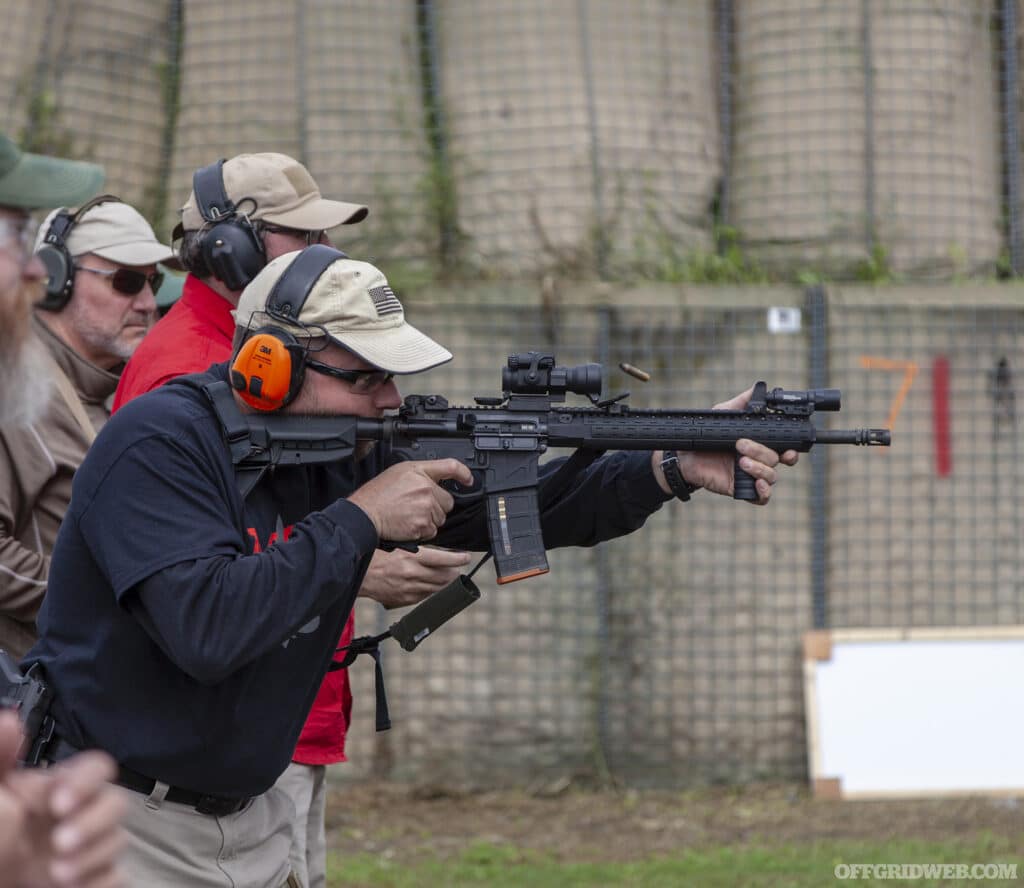
Above: Hearne’s live-fire courses focus on applying cognitive processes to firearms-based self-defense problems.
If you could make a magic wand and change police training at an institutional level, what would that consist of?
JH: This is worth an entire article by itself. In a nutshell, the whole enterprise needs a reboot, starting with hiring. The sad fact is that most police training is bad training. Very few people understand the underlying factors that make for good training, and we just rush people through with the full knowledge that recently graduated recruits won’t retain what they tried to learn in seven months after they leave the academy. The people trusted to instruct are rarely deep experts in the area they teach, and they often lack the ability to effectively convey what they do know. Often, the training division is where the misfits who weren’t suitable for the field but couldn’t be fired are warehoused. We have to accept that building people who perform takes time, effort, and resources. Rushing someone through a 10- or 12- week academy just doesn’t work. There isn’t enough time to legitimately ingrain the skills we expect police officers to possess.
Even if we had a perfect academy experience, agencies are unable and/or unwilling to give their officers the recurring training they need to stay proficient. There is no way for the limited training infrastructure to allow officers to practice empty hand skills, shoot their firearms, and practice other critical skills at the regularity that allows proficiency. These are monthly, if not weekly, training requirements, and nobody is willing to pay to have proficient officers.
On the flip side, what trends do you see in civilian firearms training as harmful to those seeking training for defensive firearms use?
JH: There are trends I see but I don’t know if I’d call them “harmful.” The concerns I have with private sector training are reflective of instructors answering the demands of the market from consumers who don’t know what they need. The industry tends to sell a lot of higher volume shooting classes with the end goal of pursuing technical excellence. There is nothing wrong with technical excellence and shooting common drills faster, but the point of diminishing returns is hit sooner than many people want to accept. What I think of as “detrimental” is limiting your development to just raw technical skill. At some point you need to focus more on skill application instead of taking another 0.05 second off your draw to first shot. At some point, you need a tactics class to know how and when to apply the skill you’ve developed. You need knowledge other than how to shoot, such as empty hands skills or medical training, and we all need to be in the best shape we can be in. I see instructors with really good classes who incorporate this sort of needed material, who struggle to fill classes simply because the round count isn’t high enough or subjects are “boring.”
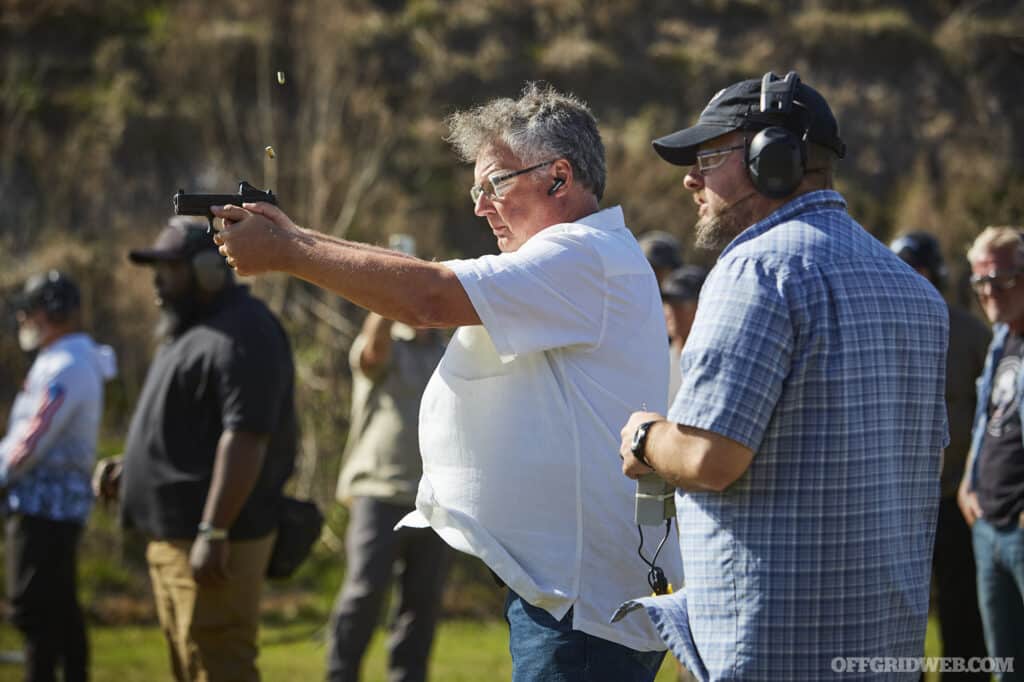
Above: John Hearne supervises cognitive-based handgun training.
How did you get into teaching/training on your own, and how did you come up with the name Two Pillars Training?
JH: I don’t know if there is a teaching gene, but if there is, my mom gave it to me. Both of my sisters are professional teachers and I’ve been teaching for decades. In graduate school, I taught SPSS [statistics software]; when I was working in IT, I remotely taught users how to use this newfangled thing called email. When I developed a serious interest in shooting, I naturally started teaching the material to anyone who wanted it. I ended up running range sessions at work before I completed my basic academy let alone firearms instructor school. I guess I had an ability to convey information effectively, and as my body of shooting knowledge expanded, I was able to convey it.
As far as my own company goes, I’ve known for a long time that I loved teaching firearms-related material and that I would be facing mandatory retirement with a young family to support. I was given some sage wisdom by Craig Douglas. He told me that for the last five years, you have to be working doubly hard — working at the current job and working to build the next job so you’ll have something to step into. My goal has been to start to build the business and frankly, to make as many mistakes as possible while I still have a day job to allow for those mistakes to be non-fatal.
Another bit of wisdom I picked up from Craig Douglas and others in the industry is to put a lot of thought into your company name. Once you start to build the brand, you really can’t change the name, even when you really want to. I wanted my company name to reflect what I’m trying to do and not be another derivation of Tattooed Tactical Combative Gunfighter Inc. The name “Two Pillars” refers to what I’m building my business on — peer reviewed scientific research and real-world best practices. In a nutshell, I’m trying to look hard at the credible scientific research as well as what the best, most successful people are doing in the real world. We have a ton of folks doing the latter, not many doing the former, and almost nobody doing both.
Many of the lectures and training courses you’ve offered under Two Pillars are heavily rooted in rigorous, academic research. How did you develop this methodology?
JH: My master’s degree taught me a bunch of relevant and useful skills — primarily the ability to review the current body of high-quality literature and gain an overview of the current understandings of a topic. When I started down this path, I found a few obscure references that I wanted to read and review out of curiosity. Any peer reviewed article is going to have a list of references at the end. I quickly realized that there was a large body of knowledge which was mostly untapped by the training community.
I realized that over the years, we had been able to stumble across best methods by trial and error, but rarely could anyone explain why we did something in a particular way. The research gave a very good explanation of the realities that tended to underlie best practices. I liken it to troubleshooting an engine. You can know what to do and that will get you so far. However, if you understand why or how an engine works your ability to repair or tune it will be much better when the standard “do this” answer doesn’t work.
I thought that it was important to set the record straight and use objective truth to form the best understanding possible. Those in the fitness community who look to the literature jokingly say they’re fighting “broscience.” I guess I’m trying to fight “broscience” in the field of human performance under life-and-death circumstances.
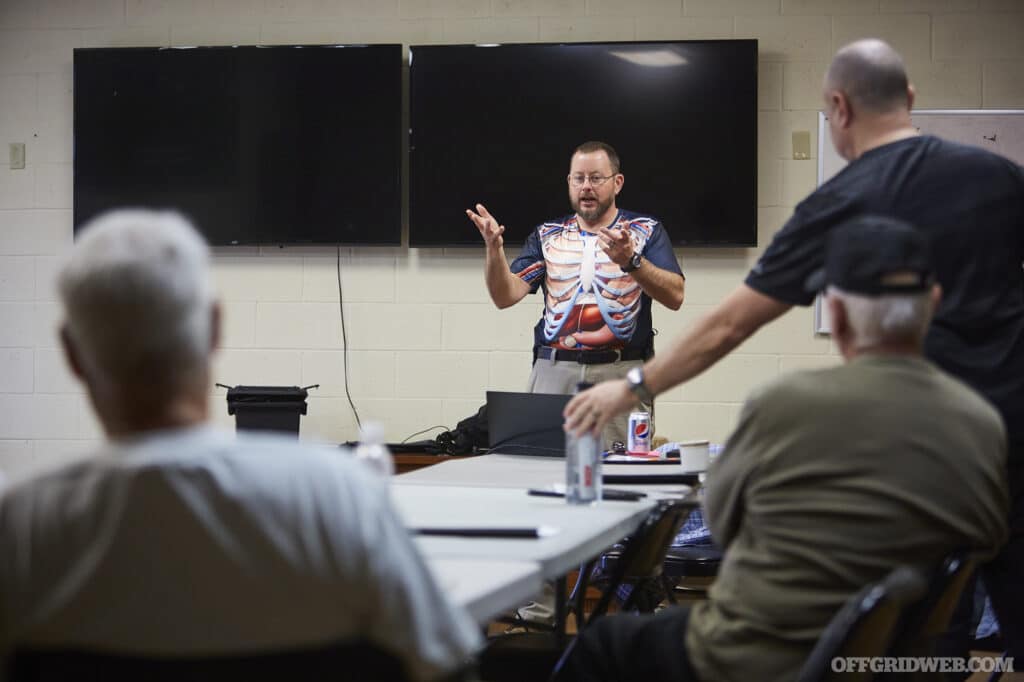
Above: In addition to his range courses, Hearne has an engaging series of lecture courses on training methodology and historical violent incident case studies.
You gave us the opportunity to sit in a couple of these lectures, one of which focused on dissecting some milestone critical incidents in law enforcement history. What benefits do armed citizens gain from studying the forensics of these types of incidents?
JH: I use both the Newhall incident and the Miami-FBI firefight as case studies when teaching armed citizens. For the typical middle-class to upper-middle-class person living in a protected bubble, the realities of criminal violence are just an abstract worry. Most of these folks have no idea what kind of people they share the earth with — evil men who don’t share the decent bourgeois values and see decency as nothing but weakness. Both Newhall and Miami feature the scary pairing of a sociopath with a psychopath. The typical decent person has no idea that folks like this exist. By pointing to actual historic events with known antagonists, you can ground the idea of evil men as something real — you can point to concrete examples and begin to realize what you have to do to prepare. We can use these events to put a human face on an abstract concept that might otherwise be dismissed.
You’ve also spent a significant amount of time digging into the evolutionary and cognitive roots of combative training. What are two of the biggest “eye-openers” you’ve learned about how humans process life-threatening situations?
JH: The biggest revelation was how much the human mind hates novel circumstances. Novel means that the mind hasn’t experienced it before and doesn’t have an existing framework to handle it or make sense of it. The best way to eliminate novelty is to be exposed to the situation and ultimately build a mental construct that encapsulates it. We can call this mental construct a “schema” or “mental map” or “mental representation,” but whatever we call it, it’s the most powerful predictor of success across a variety of fields from martial arts to medicine. Without a solid mental map, almost all of the raw technical ability is wasted since the mind doesn’t know when and/or how to apply it. In a nutshell, training in skill application trumps training in pure skill every day of the week and twice on Sunday.
The second revelation was the role that recency played in predicting performance. If you understand how the human mind learns, stores, and sheds motor programs, you realize that skills which aren’t practiced regularly fade away very quickly. For many life-saving skills, the last time you practiced the skill is the most important factor in predicting your ability to perform it in dire times. A chart that I found from the Center for Naval Analysis says it best: “People rust faster than equipment.” If you’re going to rely on a firearm to defend yourself and others, you’ll need to handle that firearm weekly and shoot it monthly. Even a small amount of well-structured rounds, like 30, will go a long way to maintaining not just proficiency but your ability to access the skill when your life is at risk.
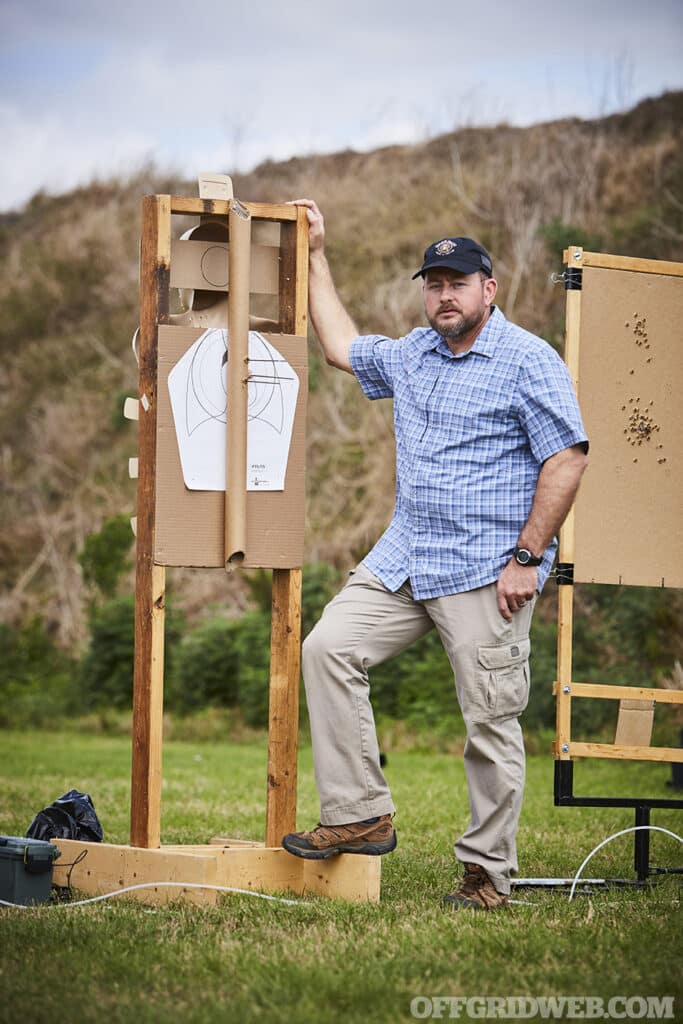
Above: John hearne inspects a shot group on a target.
How do you try to incorporate these lessons into your work as a firearms instructor?
JH: The academic body of knowledge can provide us with both subtle and direct guidance on how to better shape our training. There are very practical examples from the world of motor learning. Most instructors don’t appreciate how many repetitions it takes for someone to begin to learn a motor skill that is new to them. By making sure that you include sufficient repetitions when introducing something new, you can really enhance your student’s progression and shorten the learning curve for them. This may limit how much material you can present in one day, but it will guarantee that what you do cover is far more likely to “stick” and be available at a later time.
We can also draw more “big picture” lessons from the literature. As mentioned above, the need to eliminate novelty and build valid mental maps should be our top priorities. If an instructor knows this, then they can interject relevant tidbits along the way. I find that small lessons regularly interjected are more useful than a major point emphasized once. For instance, when I teach tactical anatomy, I show people who have sustained life ending wounds yet are fully capable of continuing to fight. This exposure helps eliminate the novelty of the situation and shows the student which mental maps are likely to be most relevant to the problem they most likely to encounter.
Modern conveniences and technology have dulled a lot of our situational awareness and “survival instincts.” What situations does the public ignorantly tend to get into trouble the most with?
JH: I’d offer two major areas of concern: being unaware in public and broadcasting information that you are a lucrative target. We know with a great deal of certainty how criminals select those they victimize. Moving about in public while immersed in your smartphone while wearing headphones that block out the audible environmental clues is a great way to become a target. The criminal wants three things (mostly): a victim that is unaware, a victim whose capabilities for self-defense are less than the attackers, and a sufficient reward to make the risk worthwhile. If you simply don’t bury your head in your phone while moving about, you’ve gone a long way down the de-selection road.
If you do have to use your phone in public, pause, look around, and plant your back against something like a wall that limits your awareness to your front. Most people don’t do that and the criminal looking for an easy target will simply remove you from the list of possible candidates. We are effectively displacing the crime somewhere else, which is sadly almost everything we can do in the current political environment.
What sort of training would you recommend the public do to protect themselves or recapture some of that cognitive survival ability?
JH: While most folks would love a one-stop solution — just take this class — I think that a deliberate effort to cultivate solid habits has the biggest return. As noted above, make a conscious effort to not use your cell phone while walking. If you want to listen to music while moving about, get a set of bone conduction headphones. This will allow you to have pretty good auditory awareness while allowing you to listen to whatever you found so compelling. Another good habit is to make a deliberate pause before moving through transitional spaces. Before exiting your car, stop and look around for a second. Ask yourself: Who’s around me and what are they doing? Before walking into or out of a store with a glass door, pause and survey where you are about to go. You may miss something relevant but the fact that this sort of behavior is fairly uncommon will likely get you passed over.
If you do want a “one-stop solution” for these sort of issues, I can’t think of much better than the Managing Unknown Contacts (MUC) curriculum taught by the ShivWorks collective — folks like Craig Douglas, Cecil Burch, Larry Lindeman, Chris Fry, or Paul Sharp. Their offerings are critical because they provide a road map for what to do if you do encounter someone who isn’t persuaded by your general attempts to be deselected. Most attackers will conduct an “interview” before launching an attack. The MUC material does a great job of not only teaching pre-attack indicators but also how to fail the potentially most important interview of your life.
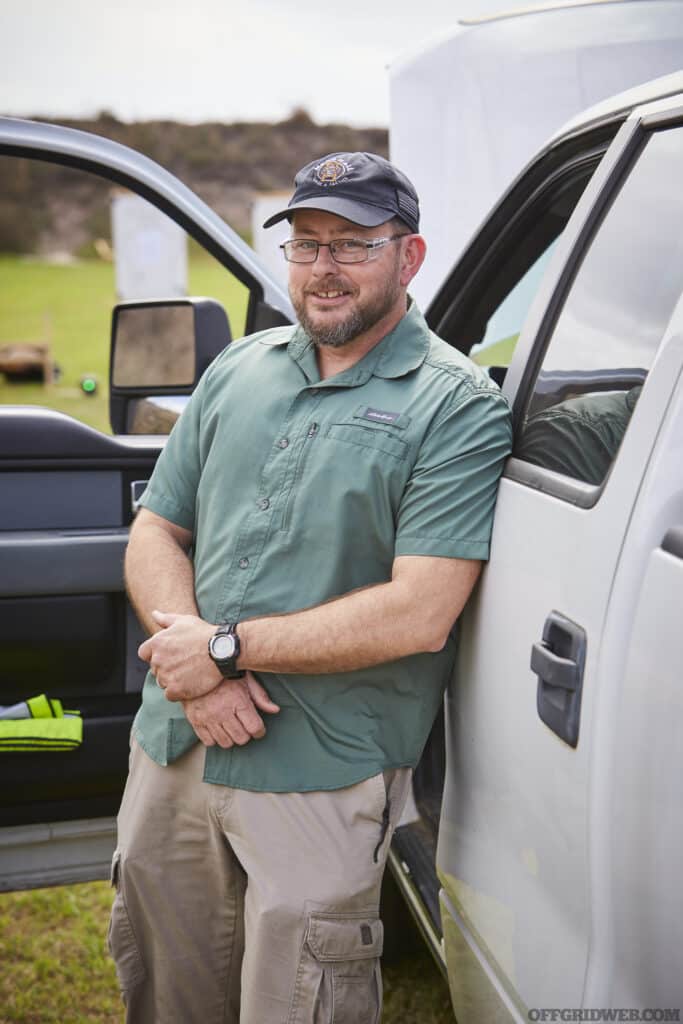
Age: 52
Current Hometown:
Painter, VA
Occupation:
U.S. Park Ranger
Recommended Reading:
Favorite Movies:
Favorite Drink:
Most any decent bourbon
Sources
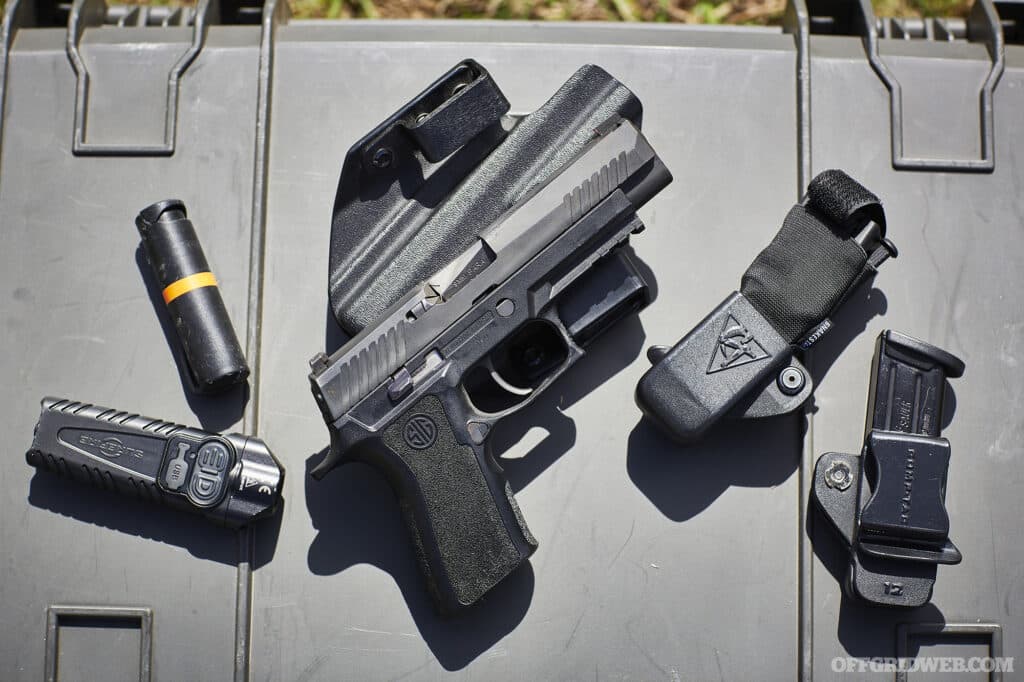
ON-DUTY
Pistol
Rifle
Medical
Misc. Tools
OFF-DUTY
Pistol
Medical
Misc. Tools
 STAY SAFE: Download a Free copy of the OFFGRID Outbreak Issue
STAY SAFE: Download a Free copy of the OFFGRID Outbreak Issue
No Comments